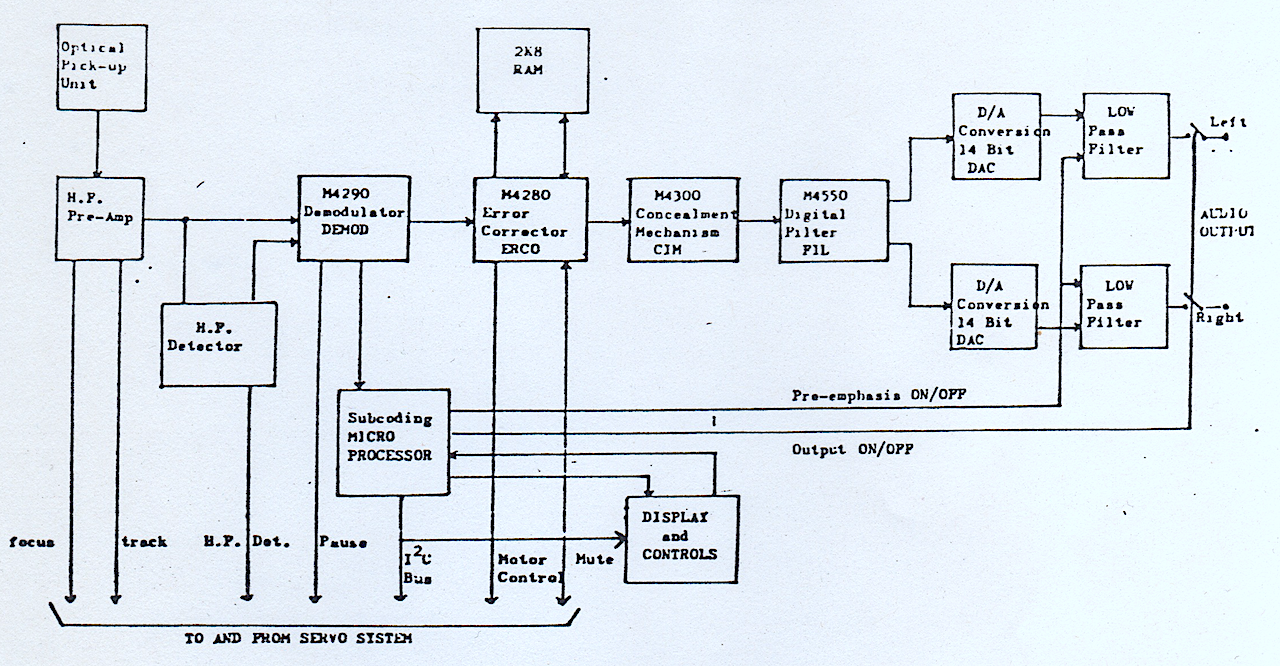Simplified Block Diagram for the Compact Disc Digital Audio System
Simplified Block Diagram for the Compact Disc Digital Audio System

SYSTEM DESCRIPTION
The information contained in the pit structures on the disc is converted to a coded input signal via the Optical Pick-up Unit. This signal is amplified and filtered to remove the low frequency tracking information and to equalise the frequency response.
The M4290 DEMOD re-generates the data rate bit clock and timing signals from the H.F. input signal. This EFM modulated signal is decoded into a N.R.Z. form and the subcoding data extracted and fed to the external Subcoding Microprocessor. The decoded 8 bit data symbols are fed serially into the Error Corrector I.C. together with timing signals
The M4280 ERCO corrects up to two erroneous symbols per fruze in the data receive from DEMOD The necessary de-interleacing to obtain the required data format is achieved by writing out the data in 8 bit parallel symbols to an external RAM and then reading it back in a defined sequence. After all possible corrections have been made the data is. fed out of ERCO in a 16 bit serial format. A further function of ERCO is to re-synchronise the data to a steady 2.1168Mhz clock rate derived from a 4.2336MHz crystal oscillator on the CIM I.C. This removes any jitter from the data while further operations eliminate wow and flutter any F.M. content in the data signal. If plus the ERCO is unable to correct error bits then the uncorrected data is passed to CIM together with an Unreliable Data warning signal.
The M4300 CIM accepts the 16 bit serial data and acts in such a way that, if the Unreliable Data signal is received, the effect of the errors is minimised. If the error results in a single unreliable sample then this is interpolated by replacing it by a new sample whose value is calculated from the values of the good sample immediately preceding it and that succeeding it. If a string of unreliable samples is samples with received then the output is muted by replacing unreliable zero value samples and reducing the value of the thirty samples preceding and succeeding them to smooth out the effects of the transition. The output of CIM is slit into fourteen or sixteen bit stereo left or right data in Offset Binary or Twos Compliment format.
The M4550 FIL is a digital interpolating filter which improves the signal to noise ratio. It also enables a simpler analogue filter to be used after the Digital to Analogue Converter (DAC). The M4550 is a low pass digital transversal filter with 96 taps. The stereo out put is organised in serial fourteen bit samples with the M.S.B. first. It is switchable between Offset Binary and Twos Compliment code. The output sample frequency is 176.4KHz which is four times the input sampling frequency.
